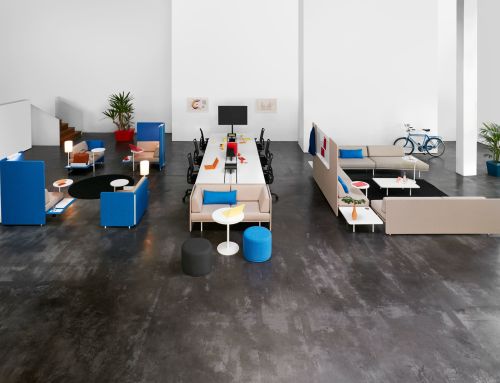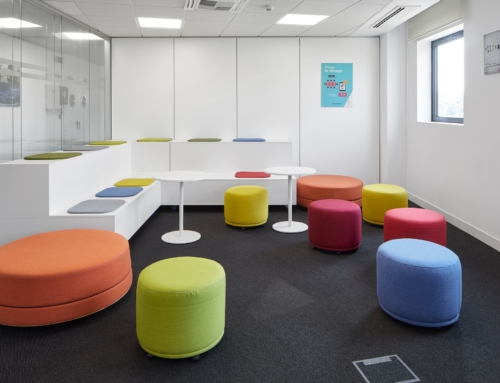These days it is ever more common to see different generations coexisting in the same office. Baby boomers, The X Generation, The Z Generation (Millennials) and now Centennials meet in one same space which makes it necessary to listen to their requirements in order to manage the design of furniture in an optimal and functional manner.
“Offices are changing and today we witness how graduates coexist in one same space with people over 45 years who are consolidating their careers” declares Martín López, Commercial Director of Ofita.
In today’s world, ever diverse and changing, says Ofita it is necessary for companies to jump onto the management of generations and adapt offices to the requirements of each group of employees, seniors and youngsters, to make them all feel comfortable in their workplaces and, therefore, to be more productive. It is worth noting that those most committed with their workplace are happier and respond being up to 30% more productive.

Four generations in one same space
Generations conceive work differently. Baby Boomers feel confident when they face targets independently although this does not mean that they cannot work in teams. Today, they are probably holding top management positions in companies so the most comfortable spaces for them are those combining collective and private and quiet spaces where they can develop simple duties just by making a call. Despite they cope with them they are not digital natives.
The X Generation has grown equally in the analogic and digital world and unlike their parents they have travelled and studied more. It is hardly surprising that among their dreams they have undertaking. Their offices have to be provided with elements which offer them new technologies and at the same time, incorporate open spaces to interact with other employees. They normally get on well with their colleagues although they also feel close to their elders.
To this two we add Millennials or the Y Generation. It has grown with technology and easily handles it so it is necessary to provide them access to all sort of digital tools in their workplaces, otherwise, they would not feel comfortable. They prefer collaborative spaces, open, fun and with a horizontal relationship with the top management. They show a favourable reaction to innovation, minimalist design and good practices of corporate social responsibility. If recruited, they will surely look for leisure areas because they need them to boost their energy.
Centennials are starting to access the labour market. Newly graduated are totally used to new technologies as they were born with them. They prefer virtual meetings, they seek immediate results –internet has always been available- and have great concern for social issues as they have been born in a more tolerant and multicultural world. When recruiting them, offices will have to provide them with all technological tools they require and incorporate them to collaborative and diverse workplaces. Otherwise, they will feel gloom.

Proposals for a new reality – Four generations in the same workspace
¿Cómo integrar todas las necesidades a la vez? La solución no pasa por escoger un tipo de oficina, sino por crear lugares que puedan satisfacer las necesidades de todos los trabajadores que conviven en ella. La idea es mezclar diferentes tipos de ambientes, por ejemplo, los abiertos destinados al trabajo más colaborativo con salas cerradas, donde se pueda recurrir para realizar labores de mayor concentración, hacer llamadas privadas, o mantener reuniones con grupos reducidos para determinadas funciones.
Ofita proposes six recommendations:
- Collaborative spaces
Thanks to the fact that most employees feel comfortable in collaborative environments which boost team work, camaraderie and common targets, the trend is to reduce tables assigned to one sole person. This idea will gain track in the next few years, when Millennials and Centennials manage the labour market. They consider them a must for an ideal work environment. At present, it is estimated that collaborative areas have already become the main characters of our spaces, representing up to 65% of them. The percentage should increase in the short-term.
- Tailor-made design
New employment demands have encouraged a more consultative design of workplaces. This means that employers shall no longer remodel their offices as a unilateral decision and based on their own beliefs but according to the expectations and requirements of their collaborators, providing training with respect to new functionalities when necessary. This process should take into consideration the demands of the different generations because they will differ. It is crucial to listen to each employee.
- Informal communication spaces
Due to the ever changing nature of how, when a where people work, organizations need more informal areas where people can meet, make private calls o simply enjoy their free time. Their purpose is to boost communication between employees of different generations and increase the quality of life at the workplace. Both Baby boomers and Centennials will welcome a place to have a coffee or relax for a couple of minutes on a comfortable sofa; even better if they have unique upholsteries or combinations of different colours as they will boost a cheerful and relaxed environment breaking with business as usual.
4. Home in the workplace
comfortable in their companies. Although traditional generations and baby boomers have grown in cold spaces without a personal touch they feel comfortable with the domestication process experimented. In turn, X and Z Generations consider it normal to decorate offices with a domestic touch as they relate it to a better quality of life and satisfaction. To achieve domestication they have to change the layout and design of furniture, incorporating simple actions such as including curtains, cushions and decoration elements.
5. A pool of spaces
In an attempt to respond to the demands of the whole organization, companies are leaving aside the premise of positions personally assigned giving place to a wide range of positions personally assigned, providing an assortment of work areas, flexible and accessible to all members. Here we see the idea of “desk-sharing” as this trend is called. Nevertheless, it has to be preferably adopted by younger members of the organization such and Millennials or Centennials. Probably baby boomers do not feel comfortable leaving their territory to someone younger.
- Access to technological tools
In Internet people already talk about the 4.0 Web and the post digital era. Organizations cannot be oblivious to this change and have to incorporate as many technological tools to their operative systems as possible and provide them to their employees. Evidence shows that empowered collaborators, those who are granted greater access to their desired applications necessary to work, have three times more opportunities to increase their productivity. This applies to all generations although without doubt, those newest will know how to make the most of this trend. It is important that the implementation of new tools comes along with training specially if we consider that not all of them are digital natives such as Baby boomers.





